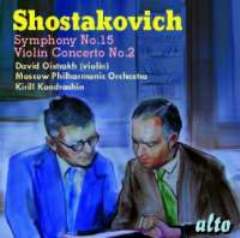Dmitri Shostakovich – Violin Concerto No.2 in C-sharp Minor (Oistrakh) [1967]
Dmitri Shostakovich – Violin Concerto No.2 in C-sharp Minor (Oistrakh) [1967]

1. Moderato
2. Adagio
3. Adagio – Allegro
Moscow Philharmonic Orchestra
Kiril Kondrashin – conductor
David Oistrakh – violin
Violin Concerto No. 2 in C sharp minor, Op. 129. As was the case with its predecessor, Shostakovich's Second Violin Concerto was inspired by and dedicated to David Oistrakh. Written in 1967 with the intention of being a 60th birthday present, the work was, by mistake, presented to the virtuoso a day early. Like many other works written following the composer's heart attack in 1966, this concerto exhibits the very dark, introspective tone, repeating rhythmic cells, and obscure thematic motifs so common to Shostakovich's later style. And like both of his cello concertos, the horn has a dominant role as accomplice and foil to the solo violin. Though the opening movement begins with some restraint, the first subject hurriedly reaches an agonized, dissonant climax. The beginning of the second subject eases the tension somewhat, with a segue into the development section by way of irreverent, mocking five-note figures that interchange with lyrical, imitative violin and wind passages. The ensuing development distorts the main thematic material until four vast, even chords announce the arrival of the recapitulation. The return is brief, however, as a long, unaccompanied cadenza, based upon the primary subject, gives way to an emotionally drained dissolution of thematic and rhythmic motiifs.The slow second movement, though more relaxed in tempo, offers no respite from the tension, confusion and sadness of the opening, as the violin seems to search for clarity and validation, but is repeatedly denied. The solo line responds by lashing out in frustration with a feral, recitative-like cadenza. The movement closes with an elegiac horn solo which is subsequently swept aside by the crass opening of the Finale. Opened by a brief series of imitative, sardonic exchanges between the violin and horn, the last movement soon settles into a frenetic, uncomfortably charged Allegro dominated by a chromatic, rondo-style theme which, while lively and complex, has bitter, sadistic undertones. The orchestra's momentum is then interrupted by a cadenza in which the introductory material is distorted and broken in a self-mocking fashion. The end of the piece finds major modality striving for dominance and eventually winning out, though the subsequent feeling is more dubious than triumphant. –Graham Olson, Rovi
download: uploaded yandex 4shared mediafire solidfiles gett mega zalivalka filecloudio anonfiles oboom
Zmieniony (Czwartek, 08 Maj 2014 15:36)








